Box 28, Arenas Valley, NM — A tiny country post office played a big role in my youth (Part 1)
In 1949, when I was six years old, my parents made the life-altering decision to transplant themselves, my sister and me from the tiny, incorporated, civilized village of Savona in New York State’s Southern Tier region to the tiny, unincorporated, less-civilized village of Arenas Valley in rural Southwestern New Mexico, six miles east of the largest town in the region, Silver City.
Dad would become the editor of the venerable, weekly Silver City Enterprise, which had begun publishing news about gunfights, fabulous gold and silver mines, and Apache attacks in 1882. For Mom, Arenas Valley was no Shangri-La: she would continue to be a housewife, coping with more dust and less water than she could ever have imagined. We lived in a small house that we rented from my paternal grandparents, who planned to move into it when my grandfather retired from his job as a machinist in the Kennecott Copper Corporation smelter at Hurley, about seven miles southeast of Arenas Valley. We would move to Silver City at that time.
In the 1950s, Arenas Valley’s population numbered about 200 residents. Arenas Valley Road had once linked Silver City with nearby Fort Bayard and other towns in the mining district — Central (now Santa Clara), Bayard, Santa Rita, North Hurley, and Hurley — and a scattering of smaller communities — Vanadium, Hanover, and Fierro. By 1949, a new highway, U.S. 180, bypassed Arenas Valley. However, tiny as the village was — little more than a hamlet — it had a post office!
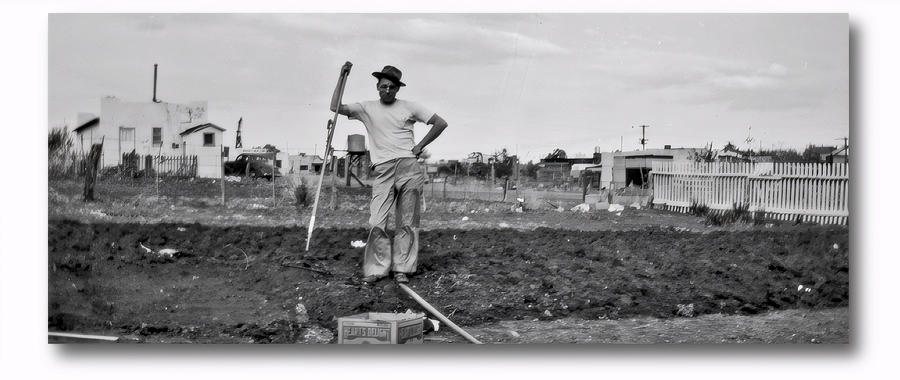
Had we moved to Arenas Valley, or Whiskey Creek
Within a few days of our arrival in Arenas Valley, we learned that…
• Many of its residents called the village Whiskey Creek.
• The large arroyo (a normally dry gully or draw in Southwestern parlance) that wound its way through Arenas Valley/Whiskey Creek was itself called Whiskey Creek.
According to the legend, at some point early in the community’s history heavy rain in the Piños Altos Range, a few miles north of Arenas Valley in the Gila National Forest, flooded an illegal still and sent whiskey barrels floating down the area’s largest arroyo. Another, more likely story, told by an amateur historian Dorothy Watson, in her bookPiños Altos Story, tells how a young man went to El Paso to buy a barrel of whiskey. On his return, near Piños Altos,1 his wagon broke down when he reached a creek near the community.
All went well on his way back until he reached the creek east of camp where he had a breakdown. He managed to get word in and the boys went down the trail with their tin cups. Nest said that he netted about $800.00 in cash and gold. There are many stories of how the creek got its name but this one is most reliable.
Regardless of the origin of its name, to call Whiskey Creek a creek has been wide of the mark for decades. It might once have been a “permanent” creek, but in the 1950s it only ran with water during the annual spring and summer Southwest Monsoons, when flash floods transported tons of New Mexico soil southward toward Mexico, some 70 miles to the south. Whiskey Creek was only 300 feet behind our house and crossed Arenas Valley Road about 1,100 feet to the southwest. It is, or at least was, a defining geological feature of the area, and certainly explains why, when it was in flood, people living in the village of Whiskey Creek were blocked from trying to driving the shortest route to Silver City. No one but a fool would dare drive through that raging water, the force of which could easily have carried away a car or pick-up.
The Rio de Arenas
It’s worth noting that Whiskey Creek the arroyo is no longer the formidable monster it often was in the 1950s (and for decades before, presumably). Today, Google’s Street View shows it as little more than a drainage ditch that has drained very little in recent years, perhaps because of the longstanding drought in the American Southwest. It’s a bit of a puzzle, though, one that I hope to address in another web page.
Miss Watson goes on to tell how the village of Whiskey Creek became Arenas Valley:
Many years later the good people ranching down the valley petitioned the legislature to have the name changed. The bill was introduced by the senator from this district. Some wag suggested “Cedarbrook”, that being the senator’s favorite brand [of whiskey]. The name was changed to Arenas Valley but the people at this end prefer “Whiskey” to “Arenas” (sand).
But why “Arenas” Valley? It turns out that another arroyo carries runoff from Piños Altos Range. It’s the Rio de Arenas, which passes through a culvert beneath Arenas Valley Road about a mile) southwest of my family’s house. I discovered Rio de Arenas only in 2025 when I was “exploring” Arenas Valley by way of Google’s useful Street View service. Although my family lived in Arenas Valley from 1949 until 1957, and I had ridden over the Rio de Arenas thousands of times in my school bus and in my family’s car, I don’t recall ever noticing it. It must then have been, as it is today, little more than a north-south depression in the slightly rolling landscape.
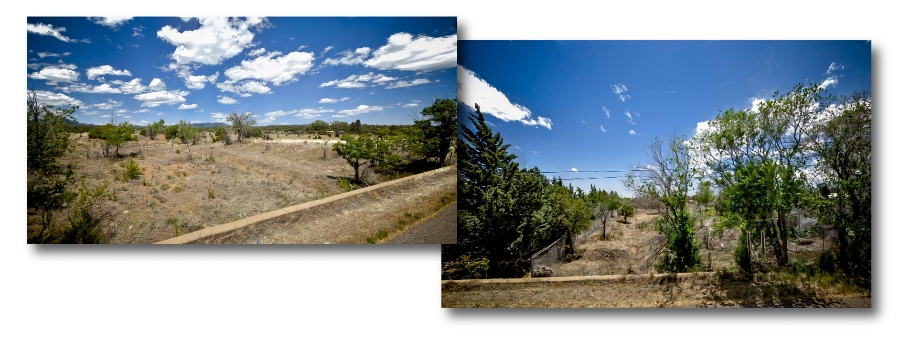
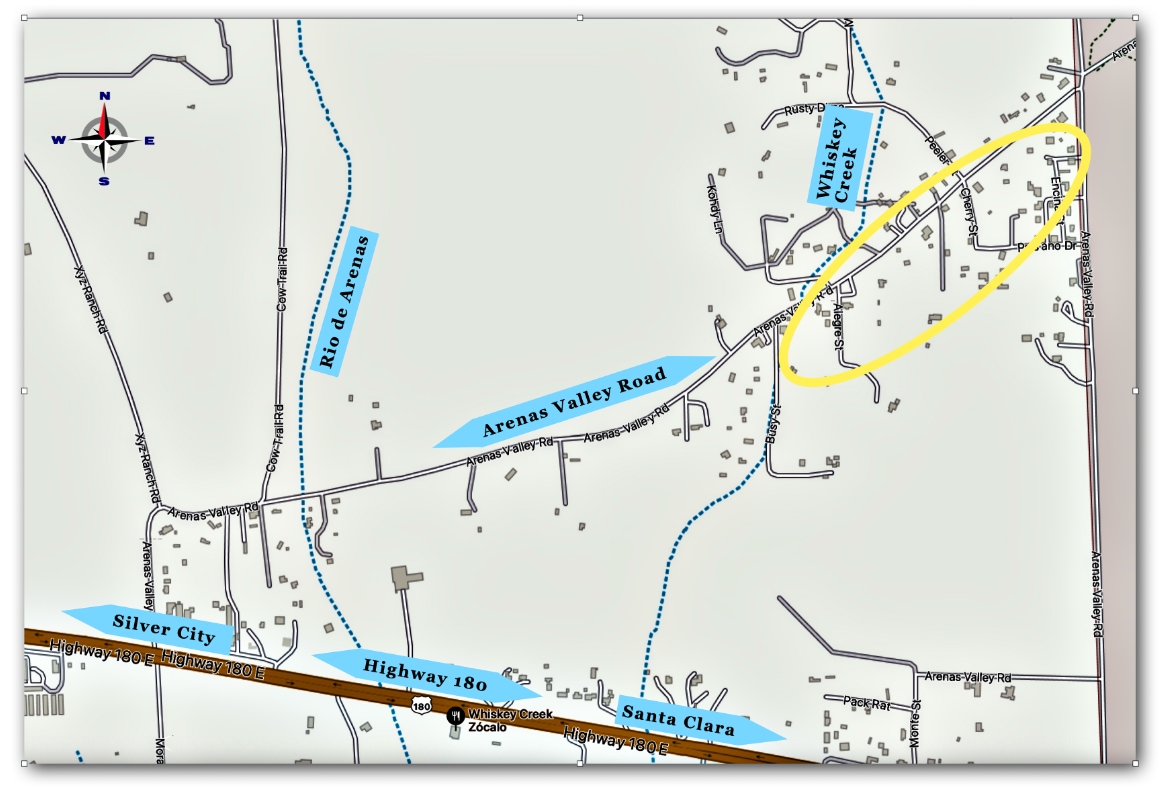
So why not Whiskey Creek Post Office?
All of which begs the question, Why wasn’t the post office named the Whiskey Creek Post Office? I’ve always assumed that the U.S. Post Office Department simply objected to the inclusion of the word “Whiskey” in the name of one of its post offices, but that may not be the case.
Kelvin Kendahl, a member of the Post Mark Collectors Club, replied to an email I sent him about the Whiskey Creek / Arenas Valley puzzle:
I don't know if the Post Office Department would have objected to "Whiskey" as part of the post office name. There were Whiskey Creek and Whiskeytown both in California already. On the other hand, those appear to be the only Whiskey post offices in the country, so maybe they did. Or maybe the residents of Whiskey Creek expected the POD to not like the name.
Arenas Valley might never have had a post office but for one resident, Mrs. Olga Harper who in 1946 applied for the opening of a post office in Arenas Valley, with herself to serve as postmaster. Her application clearly assumes that the post office would be the Arenas Valley Post Office:
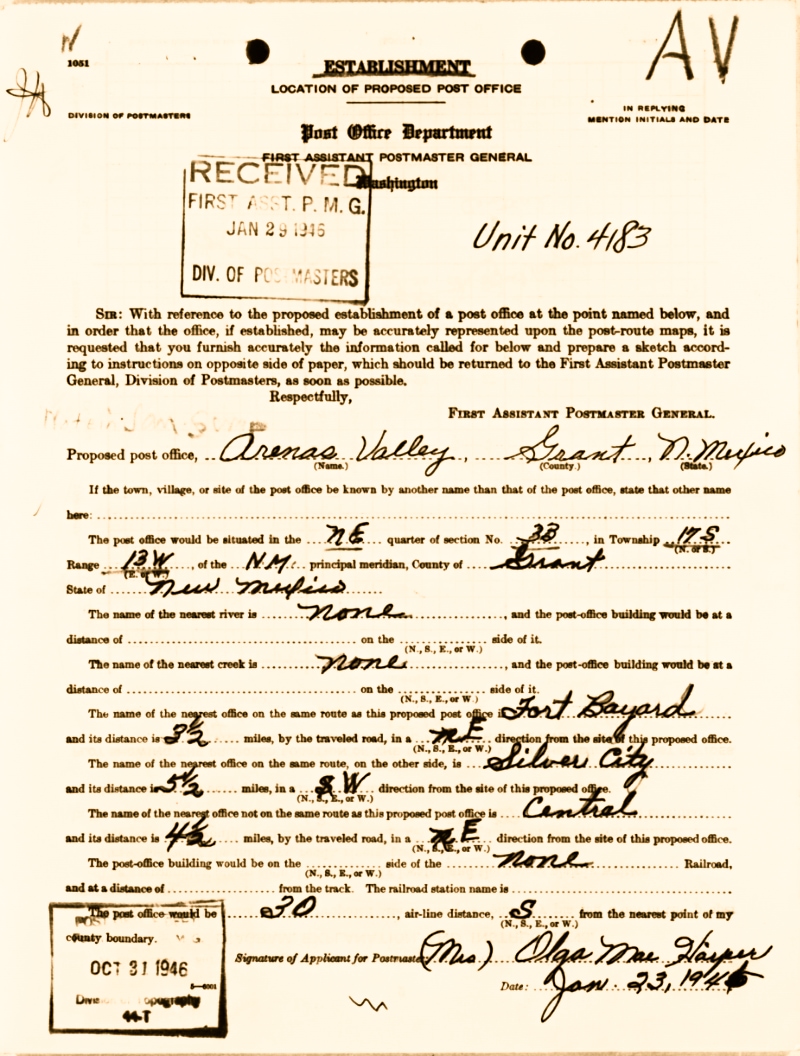
Here’s a possible explanation for Postmaster Harper’s choice of Arenas Valley as the name for the post office rather than Whiskey Creek. I spent many hours in the Harper home. Mrs. Harper’s son, Ernest, became my best friend, and I often hung out with him, his older brother, James, and his younger brother, Ira. Not once did I notice evidence of alcohol in their home. And Mrs. Harper was a Christian. Although she didn’t attend church, as far as I know, she did attempt to raise her children as Christians. Sometimes she made them listen, unwillingly, to Sunday morning radio broadcasts of sermons from local fundamentalist churches. Assuming that Mrs. Harper was a teetotaler, perhaps even a member or at least a supporter of the Women’s Christian Temperance Union, it’s possible that the last thing she wanted was to have the name of “her” post office tainted by drink.
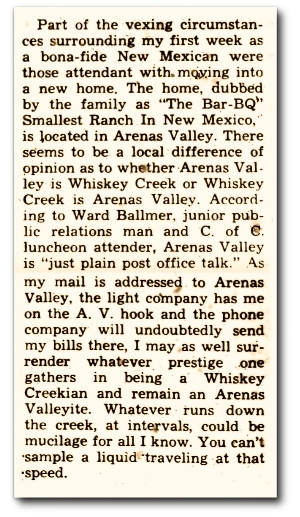
Whatever the reason for choosing the name Arenas Valley for its post office, even residents of the village weren’t clear about its “real” name. My father was so confused about which name was “correct” that the puzzle became a subject in one of his early columns, titled This World Of Mine, published in August, 1950 and reproduced at the right:
So, in the absence of other information, why Whiskey Creek became known officially as Arenas Valley, at least by the Post Office Department, remains a mystery. But there’s another mystery as well. Kelvin Kendahl explains:
I was surprised that a new office was opened as late as 1946. The total number of post offices in this country has been going down since about 1901, when there were about three times as many as there are now. As rural free delivery started to become widespread, it replaced a LOT of post offices. Of course, I also see things from a New England perspective, where things were a lot different. Very few post offices opened after 1901 in this part of the country.
Even if most Arenas Valley folks could easily travel to Silver City, I think in 1946, it was still seen as important to provide services to the residents there, as opposed to today, when it's assumed that everybody goes to Silver City often enough that services aren't necessary in Arenas Valley. That may have contributed to it, but doesn't explain why the post office didn't open 20 or 40 years earlier than it did.
On December 13, 1946 Arenas Valley, Mrs. Olga Harper was named postmaster.2
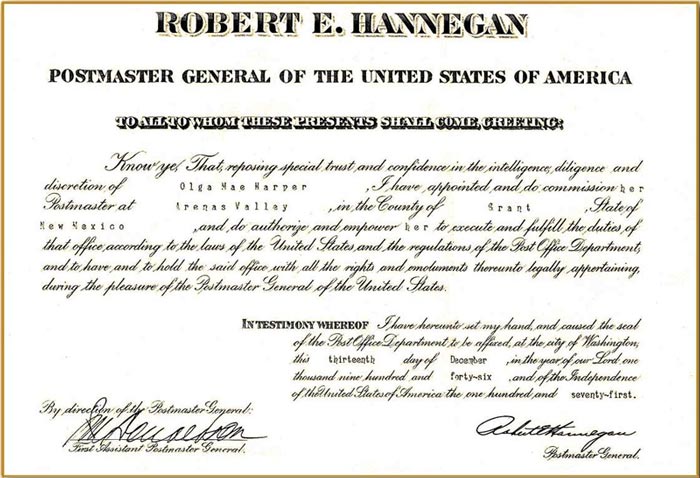
The post office, located in the Harper’s ramshackle home, opened for business on January 1, 1947, adjacent to the Harper’s former living room, which had been turned into a small “corner store”. I recall the store, but not the post office as it was then.
Mrs. Harper’s job required more than selling postage stamps, postal savings stamps, and money orders, as well as distributing mail to the mailboxes, weighing parcels, etc. She had to submit regular reports to the Post Office Department. This cover3 illustrates her submission of one such report:
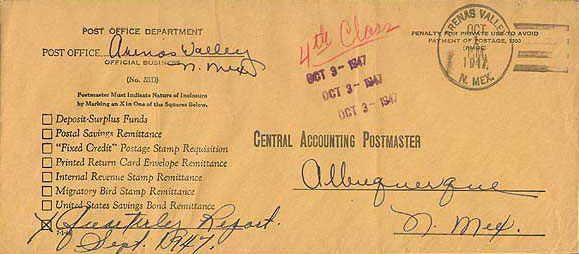
-
The pioneer gold- and silver-mining community of Piños Altos is located high in the Piños Altos Range about five miles north-northwest west of Arenas Valley. ↩︎
-
The term postmaster is gender neutral; Postmistress and postmaster have been used interchangeably in the United States since Mary Katherine Goddard served as Baltimore’s postmaster from 1775-1789. She was the only female postmaster when Benjamin Franklin was named the first American Postmaster General in 1775, making her the first known postmaster (or postmaster) or in the United Colonies, predecessor of the United States. ↩︎
-
A cover is the name that philatelists give to envelopes, particularly envelopes that have moved through the mail stream. The stamps, cancellation, addresses, and various postal markings often provide significant information about the senders, recipients, time and route of transit, and even evidence of delays caused by crashes, fires, political unrest, wars, and storms. Enclosed letters sometimes include information — philatelic gold! — that is missing in history books or TV documentaries. ↩︎